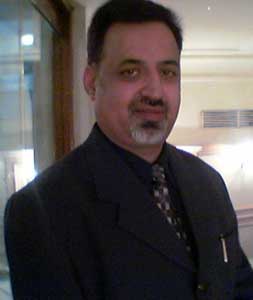|
|
|
|
|
|
|
|
|
|
|
|
|
|
|
A solar system consists of:
2.How many planets are there in our solar system? Our solar system has 9 planets and
one star: the Sun. They are : Mercury, Venus, Earth, Mars, Jupiter, Saturn,
Uranus, Neptune and Pluto. An easy way to remember them is: My Very
Educated Mother Just Served Us Nine Pakodas.(M for Mercury,V for Venus
etc)
3.How did this solar system begin/form? Theory of it's formation. The planets, asteroids and comets
in the Solar System are loose particles left over from the formation of
the Sun. Originally the gas and dust which would become the Sun was
the core of a cloud much larger than the Solar System, probably several
lightyears(far far away) across; where 1 light-year is equal to approximately
10,000,000,000,000 miles. The core was slowly rotating at first, but as
it collapsed it spun faster,
Gas and dust in the disc spiraled
gradually in to the center, where it accumulated to form the Sun. But because
dust is denser than gas, some of the dust settled to the mid-plane
of the disc. These dust particles stuck together to make clumps, then clumps
stuck together to make rocks,
So the Sun is the collapsed core
of an interstellar gas cloud, and the planets, asteroids and comets are
small lumps of dust which stayed in orbit instead of spiraling into
the Sun. The planets all formed within a very short period, probably a
few million years, about five billion years ago.
4.How old is our solar system? The solar system is said to be over
5 billion years old.
5.And how big is our solar system? There are no physical boundaries
in space. The solar system consists of nine planets orbiting around one
star: the Sun. Pluto, the farthest planet from the Sun orbits approximately
as far as 40 astronomical units. An astronomical unit is a unit of length
used by astronomers. One astronomical unit equals the distance from
Earth to the Sun: 93 million miles.Really too big for us to imagine!
6.What are the differences between our planets? Planets are different in sizes and
colors. The four planets closer to the Sun are called 'rocky' planets.
They are small in size and similar to Earth in composition. They
have no rings and only two of them
The four outer planets, also called 'gas giants', are much larger than the 'rocky' planets. They all have rings and have many moons. The 'gas giants' are made up mostly of hydrogen, helium, frozen water, ammonia, methane, and carbon monoxide. Pluto, the most remote planet, might be little more than a giant comet. Its composition is similar to that of comets, and its orbit is quite different from that of the other comets and planets. Pluto has one moon: Charon.
7.What is the asteroid belt? The asteroid belt is a zone between
the orbits of Mars and Jupiter. It is said that the asteroids in the asteroid
belt never formed a planet because the gravity of nearby Jupiter
kept pulling them apart. Today, millions of asteroids probably inhabit
the asteroid belt, with many more scattered throughout the solar
system.
8.Where do planet come from? Comets are solar system leftovers;
they are often described as 'dirty snowballs', lumps of frozen gas and
dust. Astronomers suspect that many of these objects live in a giant
cloud called the 'Oort' Cloud, that extends as much as a light year from
the Sun
9.Can we ever see planets with our naked eye? Yes! Some planets can be seen with
the naked eye (Without telescope or binoculars). That is how they were
discovered by the ancient civilizations: Mercury, Venus, Mars, Jupiter
and Saturn.
10.Which are rocky or terrestial planets? Mercury, Venus, Earth and Mars are
called 'rocky' or' terrestial' planets. They are similar to Earth in composition.
Being close to the Sun, lightweight elements like hydrogen and helium
were sandblasted away by the intense radiation. Mostly rock and metal was
left in this zone and
11. What are gaseous planet? Jupiter, Saturn, Uranus and Neptune
are called the gaseous planets. Jupiter and Saturn contain the largest
percentages of hydrogen and helium, while Uranus and Neptune contain
largest shares of ices -- frozen water, ammonia, methane, and carbon monoxide.
12.And which planets have rings? The four gas giants, Jupiter, Saturn,
Uranus and Neptune, have rings.
13. How powerful is the Hubble telescope? Hubble is one of the worlds most
powerful telescopes.(for more details see our sites/links page).
14.Can the Hubble telescope take pictures of the sun too? No. The Sun is too bright for the Hubble Space Telescope to observe. Its bright light can damage the telescope's sensitive detectors. PLANETS IN OUR
SOLAR SYSTEM
|
|
|
|
|
|
|
|
|
|
|
|
| India, New Delhi From Space |

Welcome to Rajesh Chopra's Guest Book and comments Please |

|
All rights reserved. No part of this publication and other sites of under liveindia.com may be transmitted or reproduced in any form or by any means without prior permission from the publisher Live India Internet Services or Rajesh Chopra, L.C.Premium Cables, 1826, Amar Nath 2nd Building, Bhagirath Palace Delhi - 110006, India. Liveindia.com or Mr.Rajesh Chopra is not responsible for any wrong information under this site, For confirmation of any information it is recommended that you can reconfirm from yours end |
 |